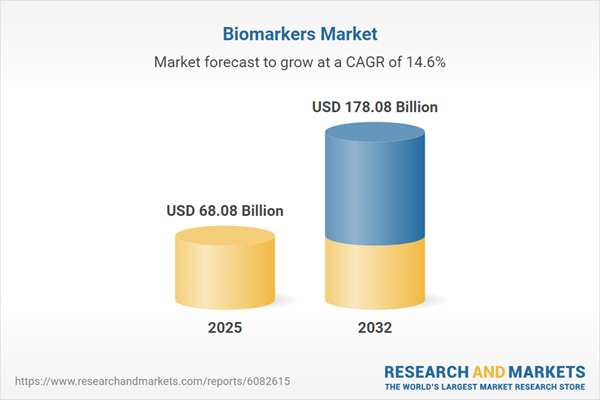Speak directly to the analyst to clarify any post sales queries you may have.
The biomarkers market is advancing rapidly, shaping the foundation of precision healthcare solutions. Senior executives will find this research especially valuable for navigating disruptive trends, evolving supply chain dynamics, and complex regulatory environments as biomarkers become increasingly essential in clinical and commercial strategies.
Market Snapshot: Biomarkers Market Growth Drivers and Outlook
The biomarkers market grew from USD 59.69 billion in 2024 to USD 68.08 billion in 2025. It is expected to continue expanding at a CAGR of 14.64%, reaching USD 178.08 billion by 2032. Growth is driven by rising adoption of molecular diagnostics, mounting integration of high-throughput technologies, and increased collaboration between pharmaceutical firms, academic institutions, and regulatory bodies. Expanding clinical applications and the convergence of digital health platforms are also fueling market momentum amid global healthcare transformation.
Scope & Segmentation of the Biomarkers Market
Comprehensive segmentation ensures actionable insights for targeting opportunities and managing risks. The report covers the following:
- Biomarker Source: Blood (plasma, serum), saliva, tissue, urine
- Technology: Immunoassay (chemiluminescent, ELISA, lateral flow), mass spectrometry (gas, liquid, MALDI-TOF), polymerase chain reaction (digital, quantitative), sequencing (next-generation, Sanger)
- Biomarker Type: Cellular, genetic (DNA, RNA), metabolomic, protein biomarkers
- Application: Clinical trials, diagnostics, drug discovery, personalized medicine
- End User: Academic and research institutes, diagnostic laboratories, hospitals, pharmaceutical companies
- Regional Analysis: Americas (including United States, Canada, Mexico, Brazil, Argentina, and others), Europe, Middle East & Africa (including UK, Germany, France, South Africa, UAE, and others), Asia-Pacific (including China, Japan, India, South Korea, Australia, and others)
- Company Developments: Analysis of key players such as Abbott Laboratories, QIAGEN GmbH, F. Hoffmann-La Roche, Thermo Fisher Scientific, and others
Key Takeaways: Strategic Insights for Biomarkers Market Stakeholders
- Biomarkers have transitioned from niche research tools to core assets in precision medicine, enabling targeted diagnostics and personalized treatment decisions across clinical settings.
- Collaboration among research organizations, pharmaceutical companies, and regulators accelerates biomarker validation and streamlines pathways for approval, supporting both commercial expansion and patient care advancement.
- Technological innovations—including integration of artificial intelligence and multiomic data—allow faster biomarker discovery, enhance diagnostic precision, and support real-time health monitoring for remote or decentralized care.
- Standardization initiatives, robust data governance, and interoperability improvements are vital to ensure data quality and promote broader adoption of biomarker solutions worldwide.
- End-user dynamics continue to evolve, with diagnostic laboratories, hospitals, and pharmaceutical enterprises increasingly integrating biomarkers into research, drug development, and routine clinical practice.
- The competitive ecosystem features dynamic partnerships, mergers, and technology-driven service expansion as organizations strive for differentiation and customer-centric growth.
Assessing Tariff Impact on Biomarker Supply Chains
United States tariffs introduced in 2025 have amplified challenges in sourcing, raised manufacturing costs, and complicated global distribution. Import duties on critical reagents and kits have led manufacturers to reevaluate procurement strategies, investigate nearshoring, and intensify supplier consolidation. Export restrictions and customs delays increase inventory pressures, especially for smaller firms. Strategic measures, including dual-sourcing and domestic capability investments, are now essential to ensure continuity and minimize disruptions in biomarker product development and delivery.
Research Methodology & Data Sources
Market insights combine rigorous desk research, review of regulatory filings, journal publications, and patent data, with primary interviews from sector leaders spanning research, diagnostics, and biopharma. Multi-phase validation using modeling frameworks, expert workshops, and fact-checking protocols underpins the credibility and reliability of findings presented in this report.
Why This Report Matters to Decision Makers
- Enables senior leaders to benchmark strategies, anticipate shifting regulatory landscapes, and prioritize technology investments to remain resilient in a competitive market environment.
- Offers clear segmentation and regional intelligence essential for identifying scalable growth opportunities and risk management across diverse operational contexts.
- Delivers actionable guidance to support supply chain agility, robust validation practices, and successful commercial expansion of biomarker-driven solutions.
Conclusion: Biomarkers Fueling the Next Era of Personalized Medicine
Biomarkers are central to advancing precision healthcare and optimizing therapeutic outcomes. Navigating evolving regulations, technology options, and market partnerships will remain key. This report delivers strategic guidance to help organizations capture value as the biomarker landscape continues to evolve rapidly.
Table of Contents
3. Executive Summary
4. Market Overview
7. Cumulative Impact of Artificial Intelligence 2025
Companies Mentioned
The companies profiled in this Biomarkers market report include:- Abbott Laboratories
- Bio-Rad Laboratories, Inc.
- APIS Assay Technologies Limited
- Augurex Life Sciences Corp
- Biocrates Life Sciences AG
- BIOINFRA Life Science Inc.
- BioVision Inc.
- EKF Diagnostics Holdings PLC
- F. Hoffmann-La Roche, Ltd.
- Merck KgaA
- PerkinElmer, Inc.
- Proteomedix AG
- QIAGEN GmbH
- Renalytix PLC
- Siemens Healthcare GmbH
- Sino Biological Inc.
- Thermo Fisher Scientific, Inc.
- Charles River Laboratories, Inc.
- Nightingale Health Plc
- BioAgilytix
- BioStarks
- Biofourmis Inc.
- Alto Neuroscience,Inc.
- Personalis, Inc.
- Owkin Inc.
- VivoSense, Inc.
- Elo Health, Inc.
- Owlstone Medical Limited
- Biognosys AG
- Clarigent Corporation
Table Information
| Report Attribute | Details |
|---|---|
| No. of Pages | 186 |
| Published | November 2025 |
| Forecast Period | 2025 - 2032 |
| Estimated Market Value ( USD | $ 68.08 Billion |
| Forecasted Market Value ( USD | $ 178.08 Billion |
| Compound Annual Growth Rate | 14.6% |
| Regions Covered | Global |
| No. of Companies Mentioned | 31 |









